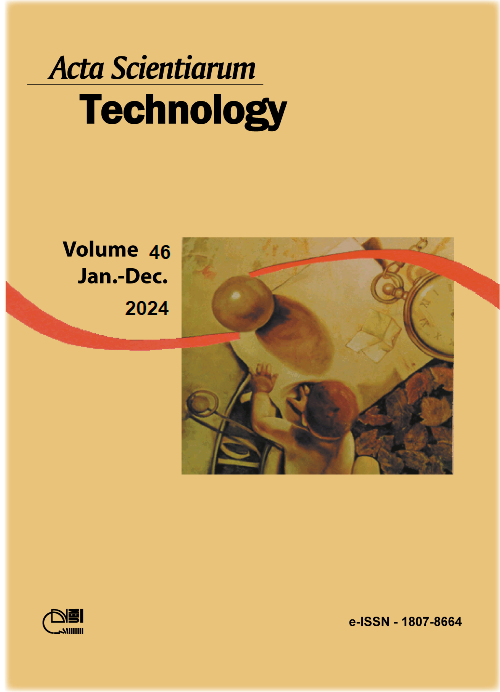Synthesis, morphological characterization, and evaluation of nano zero-valent iron (nZVI) in the degradation of water contaminated with POPs
DOI:
https://doi.org/10.4025/actascitechnol.v46i1.66777Palavras-chave:
Heterogeneous catalysis; POP; nanostructured zero-valent iron; remediation; kinetic tests.Resumo
Nanostructured zero valence iron (nZVI) has been applied in advanced oxidative processes aimed at the treatment of water contaminated with Persistent Organic Pollutant (POP). Considering that such compounds cannot be eliminated by traditional treatment methods, this study proposes the synthesis of nZVI by the reduction of Iron Chloride III by sodium borohydride in the absence of O2, in ultrasound bath. The material obtained has only a wide diffraction halo at 45.13º of 2θ, with an average diameter of the crystallite calculated at 8.3 nm. The method of Brunauer, Emmett and Teller (BET method) analysis infer that the synthesized material is classified as mesoporous and showing a large surface area of 91.48 m2.g-1. According to transmission electron microscopy (TEM) the compound exhibits a core-shell type structure being the average size smaller than 50 nm. Thermogravimetric analysis demonstrates that the compound is thermally stable, exhibiting only a thermal event close to 70º C in which there is a loss of approximately 25% of mass related to water loss. The synthesis was efficient because there is no formation of metal oxides and no residue from the synthesis process according to FT-IR analyzes. To evaluate the effectiveness and present the parameters that most positively contributed to the degradation of water contaminated with 24 of the most common POPs, a chemometric study was applied considering the following variables: reaction time, concentration of applied iron nanoparticles and pH values. The approach reduces costs, time, and waste generation. Among the variables, reaction time is crucial, mainly due to solubility differences between compounds. Kinetic tests show increased efficiency after one hour, emphasizing a direct correlation between degradation rate and water solubility for the studied POPs.
Downloads
Downloads
Publicado
Como Citar
Edição
Seção
Licença
DECLARAÇíO DE ORIGINALIDADE E DIREITOS AUTORAIS
Declaro que o presente artigo é original, não tendo sido submetido í publicação em qualquer outro periódico nacional ou internacional, quer seja em parte ou em sua totalidade.
Os direitos autorais pertencem exclusivamente aos autores. Os direitos de licenciamento utilizados pelo periódico é a licença Creative Commons Attribution 4.0 (CC BY 4.0): são permitidos o compartilhamento (cópia e distribuição do material em qualqer meio ou formato) e adaptação (remix, transformação e criação de material a partir do conteúdo assim licenciado para quaisquer fins, inclusive comerciais.
Recomenda-se a leitura desse link para maiores informações sobre o tema: fornecimento de créditos e referências de forma correta, entre outros detalhes cruciais para uso adequado do material licenciado.















